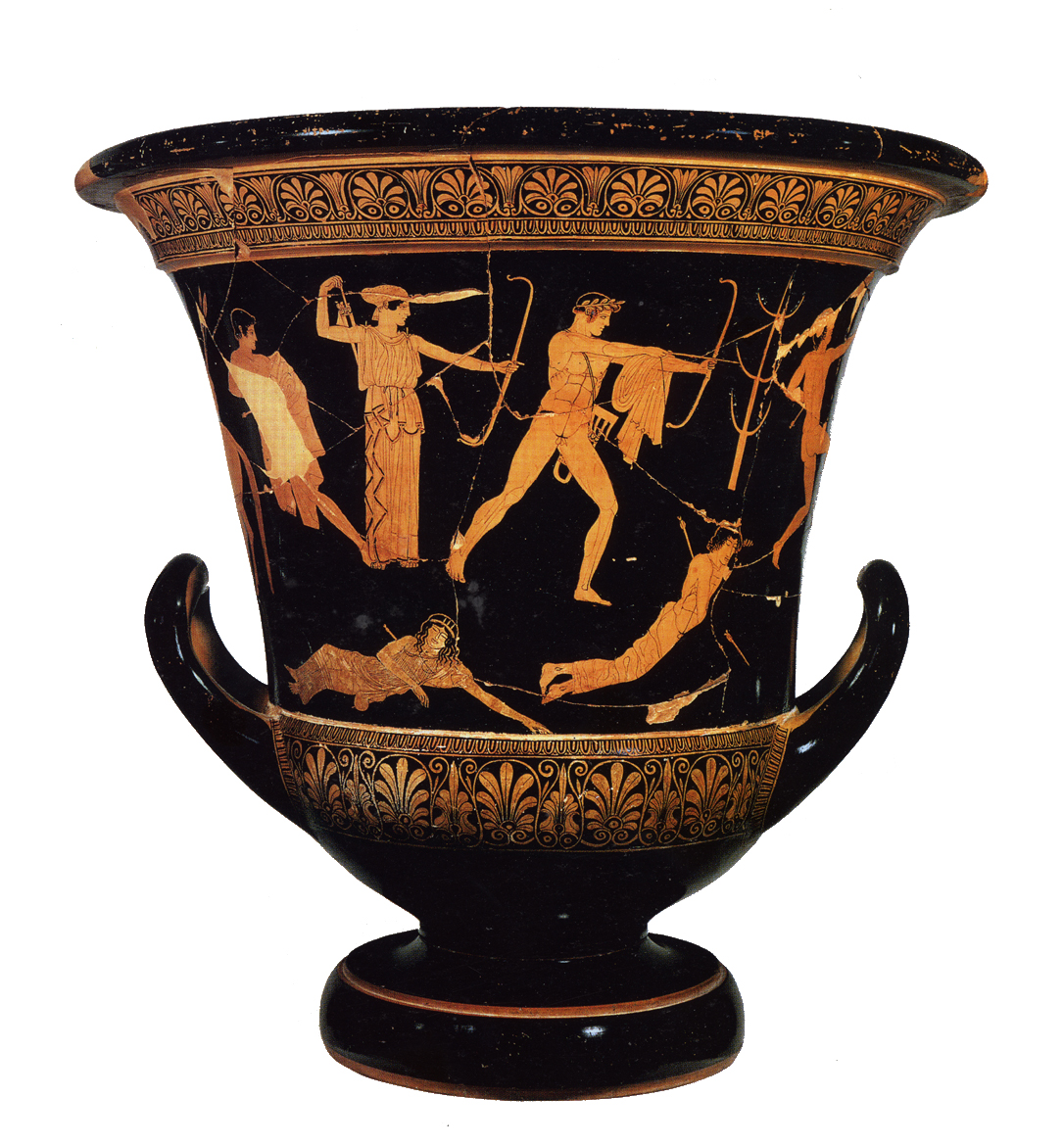Ceramics - Greek Amphora
amphora, ancient vessel form used as a storage jar and one of the principal vessel shapes in Greek pottery, a two-handled pot with a neck narrower than the body. There are two types of amphora: the neck amphora, in which the neck meets the body at a sharp angle; and the one-piece amphora, in which the neck and body form a continuous curve. The first is common from the Geometric period (c.900 bc) to the decline of Greek pottery; the second appeared in the 7th century bc. The height of amphorae varies from large Geometric vases of 5 feet (1.5 metres) to examples of 12 inches (30 centimetres) or even smaller (the smallest are called amphoriskoi). The average normal height is about 18 inches (45 centimetres). Amphorae, which survive in great numbers, were used as storage and transport vessels for olives, cereal, oil, and wine (the wine amphora was a standard Attic measure of about 41 quarts [39 litres]) and, in outsize form, for funerals and as grave markers. Wide-mouthed, painted amphorae were used as decanters and were given as prizes.
Black Figure Neck Amphora Red Figure Neck Amphora
Red Figure Neck Amphora

i think these are really cool. i like how old they are and how good they look. my favorite part about them is the little arms they have coming out of the side and how tall they are
ReplyDeleteBryant Beall
An amphora (English plural: amphorae or amphoras) is a type of container of a characteristic shape and size, descending from at least as early as the Neolithic Period. Amphorae were used in vast numbers for the transport and storage of various products, both liquid and dry, but mostly for wine. They are most often ceramic, but examples in metals and other materials have been found.
ReplyDeleteThe amphora complements the large storage container, the pithos, which makes available capacities between one-half and two and one-half tons. In contrast, the amphora holds under a half-ton, typically less than 100 pounds. The bodies of the two types have similar shapes. Where the pithos may have multiple small loops or lugs for fastening a rope harness, the amphora has two expansive handles joining the shoulder of the body and a long neck. The necks of pithoi are wide for scooping or bucket access. The necks of amphorae are narrow for pouring by a person holding it by the bottom and a handle. Some variants exist. The handles might not be present. The size may require two or three handlers to lift. For the most part, however, an amphora was tableware, or sat close to the table, was intended to be seen, and was finely decorated as such by master painters.
I think it is incredible that they are able to make such intricate designs on these pots. My favorite part is the contrast on the pots.
-Alex Bercik
this has been plagiarized
DeleteI think these ancient pots are cool. I like the action that's going on in the middle of the pot too. It should be fun making these.
ReplyDelete- Torrian McSwain
I love how each of these show action on still pots. I also love the symmetry Greek Amphora pots always exhibit. I can't wait to make these either!
ReplyDeletei think these pots are really cool. I think that these will be fun to make and i'm interested to see how these will turn out.
ReplyDeleteAustin Bardash
These are cool. I want to make one like in the movie hercules...I mean hunkules
ReplyDeletewhy
Deletei think that how symmetrical each pot is is pretty amazing and i think the painting are incredibly detailed and beautiful.
ReplyDeleteThis comment has been removed by a blog administrator.
Deletei like these, these are cool pots they seem difficult.
ReplyDeletei like these and i think it'll be fun cause i mean anything is better than throwing on the wheel
ReplyDeletehenry
i think that these pots are awesome. they are very detailed and intricate. this will be a fun project.
ReplyDeleteI like the symmetry of these pots and hope mine will look good when completed.
ReplyDeleteJohn Lester
I like those pots, they look really nice.
ReplyDelete-Jack Yang
These pots came out very symmetrical and clean, I really enjoy the process of building although it is at times frustrating to get the right form.
ReplyDelete- Avery Hobbs
I really like the pot show in the page, they all look fantastic, but it might be hard to make it especially the out look.
ReplyDeleteWill Sun
adidas ultra boost
ReplyDeletemoncler jacket
goyard handbags
jordan sneakers
balenciaga
supreme clothing
calvin klein outlet
nike air max 90
golden goose outlet
moncler outlet
ytuidnh349sdsd
ReplyDeletesupreme outlet
golden goose outlet
golden goose outlet
golden goose outlet
golden goose outlet
supreme outlet
golden goose outlet
golden goose outlet
golden goose outlet
golden goose outlet